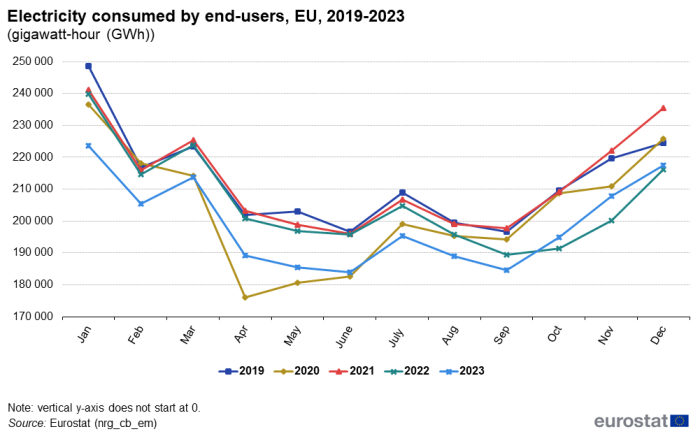Energy statistics - latest trends from monthly data
Data extracted in June 2024
Planned article update: June 2025
Highlights
2023 saw the lowest level of natural gas consumption reported in the EU since 2019.
Crude Oil and Petroleum Products imported directly from Russia to the EU plummeted by 86.5% in 2023 compared with 2021, decreasing from 171 302 thousand tonnes in 2021 to 23 107 thousand tonnes in 2023.
Hard coal consumption in the EU decreased from 176 019 thousand tonnes in 2019 to 127 998 thousand tonnes in 2023, representing a decrease of 27.3%.
- Interactive graph: Net electricity generation by fuel type, per month, EU.
Introduction
This article looks at certain aspects of fuel supply from the recently available monthly data for 2023 for different fuels in the European Union (EU), and compares it with those of 2019 to 2023 to observe the trends and differences the sanctions may or may not have made in the EU's energy market in the actual context.
During 2022, in response to the war of aggression against Ukraine, the EU began imposing sanctions against Russia, the largest supplier of fossil fuels to the EU. By June 2022, the Council had adopted the sixth package of sanctions that prohibited, amongst other things, the purchase, import of coal and other solid fossil fuels, crude oil and certain petroleum products from Russia into the EU.
In addition to the above measures, the Commission published in March 2022, an amendment of the Regulation on measures to safeguard the security of gas supply (EU/2017/1938) to deal with market imbalances for energy and to ensure the filling of gas storage facilities in the EU. On August 2022, the Council adopted the emergency Regulation on coordinated demand reduction measures for gas (EU/2022/1369), encouraging EU countries to reduce their natural gas demand by 15 % for the winter 2022-2023, thereby complementing the Regulation 2017/1938 on the security of gas supply.
On 30 March 2023, amid persisting risks and challenges in the energy market, the Regulation (EU) 2023/706 - was adopted by the Council of the European Union extending the coordinated gas demand reduction measures till 31 March 2024 to help avoid supply issues for winter 2023/2024 and fully compensate for the permanent decrease in Russian gas. Regulation 2023/706 also encouraged the Commission and EU countries to monitor and report the data on savings per sector every month, in addition to total gas demand every 2 months. In addition to previous measures, on 25 March 2024, the Council formally adopted the recommendation that encourages EU countries to continue reducing their gas consumption until 31 March 2025 by at least 15 %, compared with their average gas consumption in the period 1 April 2017 to 31 March 2022.
Full article
Coal consumption
The use of solid fossil fuels in the EU has been declining steadily for years. Perhaps, due to high CO2 prices (see EU emission trading scheme), many Member States have been reducing their use of coal for electricity generation. The monthly figures for hard coal used in power and heat generation have been decreasing gradually. Figure 1 shows that as of June till the end of the year (2023) the monthly amounts of coal used for electricity generation were the lowest in the last 5 years. Figure 2 shows the monthly shares of coal used for electricity generation in the EU expressed as a percentage of total coal consumption. When adding the monthly figures to give an annual percentage of coal use for electricity generation, in the years 2019, 2020 and 2021 it dropped from 47.1 %, to 44.6 % and increased to 45.8 %. Some of the highest percentages of consumption of hard coal in electricity generation were seen in 2022 where the figure for the year rose to 52.7 %, but it fell again in 2023 to 47.5 %, thus remaining above its share in 2019.

Source: Eurostat (nrg_cb_sffm)

Source: Eurostat (nrg_cb_sffm)
Several EU countries have stopped producing hard coal, but despite this, almost all EU countries still consume hard coal. The monthly hard coal consumption figures added together give a total for 2023 of 127 999 thousand tonnes. This was the lowest figure for the last 5 years. The next lowest amount during the 5 year period was 140 276 thousand tonnes, measured in 2020. Figure 3 shows the monthly consumption of hard coal in the EU in 2019, 2020, 2021, 2022 and 2023. The lowest consumption levels were observed in early to mid-2020, but by the second half of 2023 consumption of hard coal dropped below these levels.
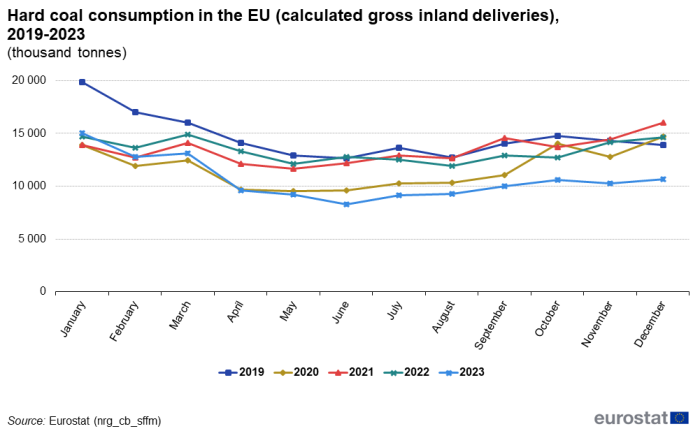
Source: Eurostat (nrg_cb_sffm)
Crude oil and petroleum products
In June 2022, the Council adopted a sixth package of sanctions that, among others, prohibits the purchase, import or transfer of seaborne crude oil and certain petroleum products from Russia to the EU. As the majority of the Russian oil delivered to the EU is seaborne, these restrictions cover nearly 90 % of Russian oil imports to Europe. Even though the oil and petroleum products sanctions applied from 5 December 2022 (crude oil) and from 5 February 2023 (refined petroleum products), many Member States sped up or initiated their own plans aimed at reducing imports from Russia almost immediately after the war of aggression began. While demand stayed stable, imports from Russia decreased from 171 302 thousand tonnes (2021 annual total) to 23 107 thousand tonnes (2023 annual total) - this is a decline of 86.51 % and 148 195 thousand tonnes in 2 years.
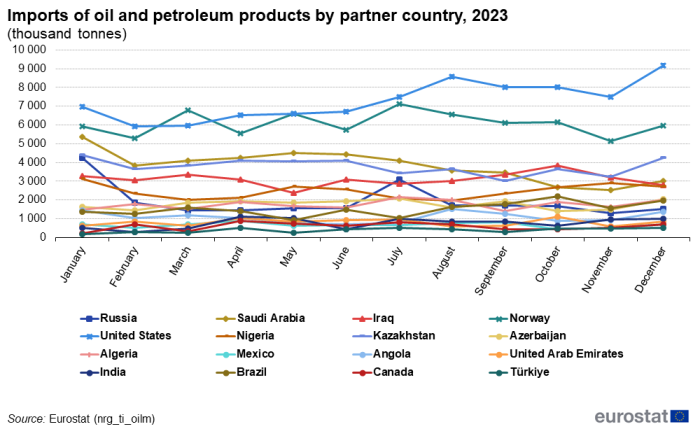
Source: Eurostat (nrg_ti_oilm)
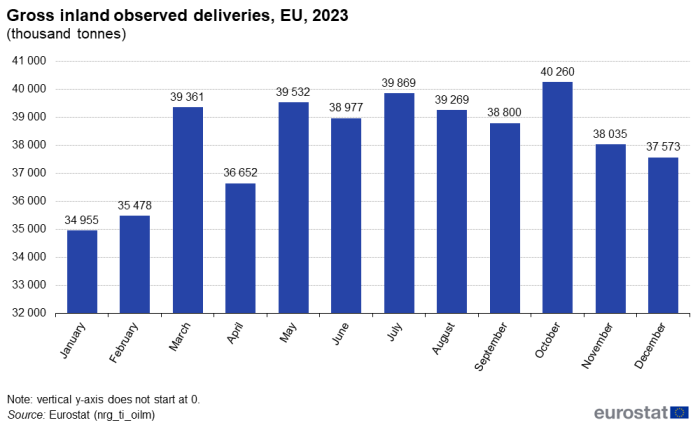
Source: Eurostat (nrg_ti_oilm)
The gap between normal demand and decreasing imports from Russia was covered by increased imports from other countries. Compared with 2019, the United States increased their annual exports to the EU by 46 803 thousand tonnes (+114.93 %), Norway by 28 267 thousand tonnes (+63.24 %), Brazil by 13 772 thousand tonnes (+307.25 %), Angola by 5 585 thousand tonnes (+76.83 %) and Kazakhstan by 8 033 thousand tonnes (21.51 %). There are six countries with highest imports to the EU in 2023 than Russia. These are the United States with 87 526 thousand tonnes and 19.1 % of the gross inland deliveries to the EU in the year, Norway with 72 969 thousand tonnes and 15.9 %, Saudi Arabia with 45 875 thousand tonnes and 10 %, Kazakhstan with 45 386 thousand tonnes, 9.9 % and Iraq with 37 308 thousand tonnes and 8.1 % and Nigeria with 29 589 thousand tonnes and 6.5 %.
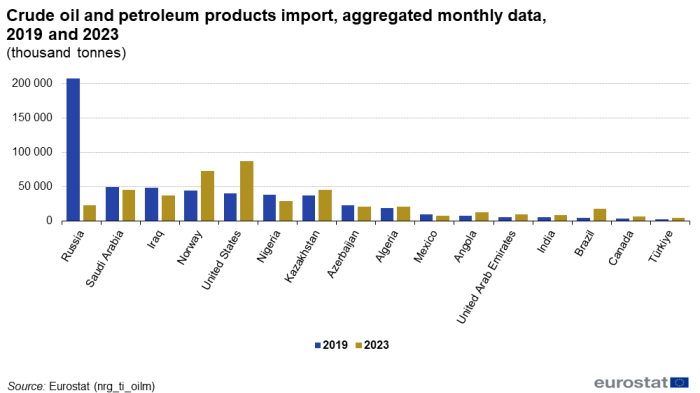
Source: Eurostat (nrg_ti_oilm)
Electricity consumption
Most economic activities depend on electricity. Therefore, electricity consumption is an indicator for economic growth, notwithstanding efficiency or savings measures. Figure 7 below shows total electricity consumption in the EU in Gigawatt-hours (GWh) for the years 2019 to 2023. Last 24th February 2022, Russia started its unjustified military aggression against Ukraine and reduced deliveries of gas in Europe. At the beginning of August 2022, a new Council Regulation 2022/1369 on coordinated demand reduction measures for gas, encouraged Member States to reduce natural gas demand by 15 %. This is an important factor as combustion of gas, amongst others, is used to generate electricity. Therefore, we could see a lower electricity consumption from August until the end of 2022. In 2023, citizens were still being urged to save electricity and gas. The overall consumption of electricity in the EU for 2023 has been the lowest of the 5 years shown in the graph, even lower than in 2020 (approximately 2.1 % less). Less industrial production, slightly milder temperatures compared with the year 2022, and the electricity saving measures might be the reasons for this decrease.
Figure 8 below shows the difference in electricity consumption in each of the Member States between 2023 and 2022. Almost every Member State consumed less electricity in 2023 than in 2022. While Cyprus (+2.3 %), Ireland (+2.2 %), Portugal (+1.6 %), Denmark (+1.5 %), Croatia (+1.2 %) and Malta (+1.1 %) consumed slightly more electricity, all other Member States consumed less from -0.1 % in The Netherlands to -7.4 % in Lithuania.

Source: Eurostat (nrg_cb_em)
An important additional factor is the heating or cooling of space or sanitary water for which certain Member States mostly use electricity. When interpreting the data, the fact that each country has its own consumption pattern and that these can be heavily dependent on outside temperatures must be considered.
Gas consumption
Natural gas is used in the production of electricity and heat. Figure 9 shows that in 2023, 16.9 % of electricity produced in Member States was generated from natural gas.

Source: Eurostat (nrg_cb_pem)
Figure 10 shows the levels of natural gas consumption in the EU by month over the last 5 years. The graph shows a clear reduction in natural gas consumption across Europe in 2023 when compared with the previous 4 years. Between January and July 2023, natural gas consumption in the EU varied between 1 594 Petajoules (PJ) in January and 703 PJ in July, indicating a monthly decrease overall, in line with the target 15 % gas reduction indicated in Council Regulation 2022/1369 on coordinated demand reduction measures for gas. The consumption in December 2023 rose to 1 512 PJ, indicating a smaller decrease than in previous months.

Source: Eurostat (nrg_cb_gasm)
For more information on gas consumption reduction at the end of 2023, please see the Eurostat article [1].
Source data for tables and graphs
Data sources
All annual values for 2019-2023 were calculated by adding the monthly data for each calendar year. All annual data used in this article correspond to totals of monthly data and as such may differ from the annual data. The reporting is based on Energy Statistics Regulation (EC) No 1099/2008.
Context
To better monitor changes in the energy market, timely data is essential to all involved. Eurostat, therefore, not only collects detailed annual energy statistics but also a reduced number of data points on a monthly basis. This monthly energy data contains information on supply and a limited amount on consumption, but can be published within 2 to 3 months, providing very early data on the energy market in each Member State and in the EU as a whole.
Direct access to
See also
Database
- Energy (nrg), see:
- Supply, transformation and consumption - commodity balances - monthly data (nrg_cb_m)
- Supply and transformation of solid fossil fuels - monthly data (nrg_cb_sffm)
- Supply and transformation of oil and petroleum products - monthly data (nrg_cb_oilm)
- Supply, transformation and consumption of gas - monthly data (nrg_cb_gasm)
- Supply, transformation and consumption of electricity - monthly data (nrg_cb_em)
Dedicated section
Publications
Methodology
- Energy statistics - quantities (European and national ESMS metadata file — nrg_quant_esms)
- Energy statistics - supply, transformation, consumption (monthly) (ESMS metadata file — nrg_10m_esms)
Legislation
- Regulation (EC) No 1099/2008 on energy statistics
Visualisations
- Explore monthly energy data - This interactive tool helps you to obtain an overview of seasonal energy trends in Europe or your country.
- European Statistical Recovery Dashboard
External links
- European Commission - Directorate-General for Energy
- European Commission - Directorate-General for Energy - Weekly oil bulletin
- European Commission - Directorate-General for Energy - Data and analysis
- Joint Organisations Data Initiative - monthly oil and natural gas world database
- International Energy Agency
